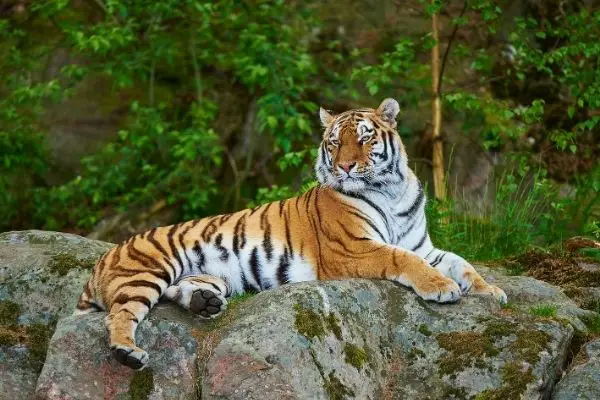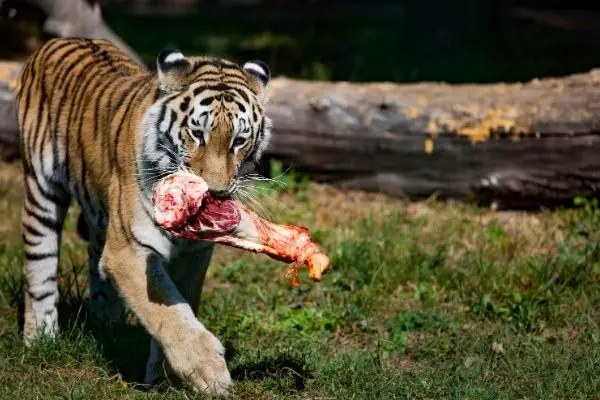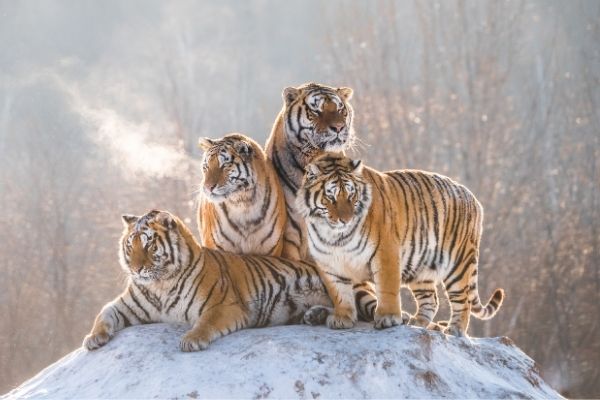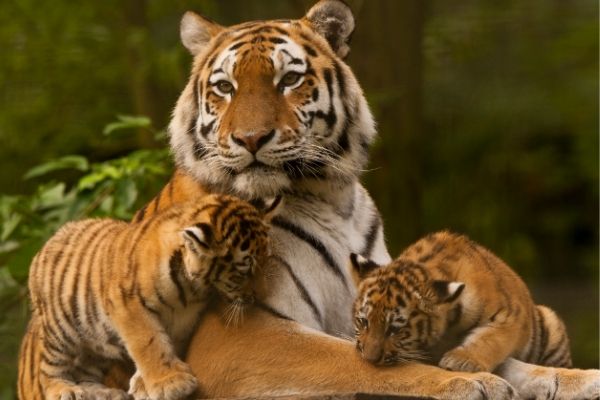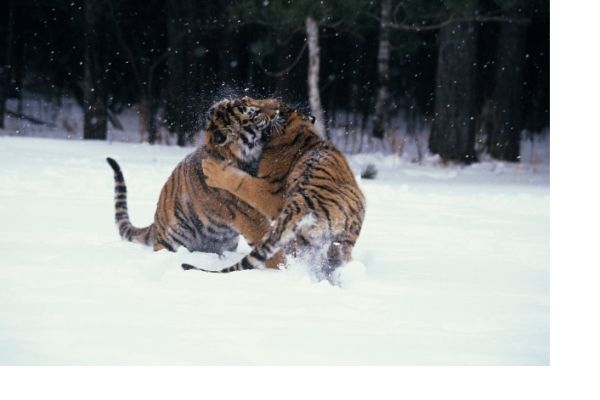The Siberian Tiger, also known as Amur Tiger, is the largest tiger species, found in the Russian Far East, Northeast China, and possibly North Korea. We have listed down complete Siberian Tiger Facts for Kids that will help you in learning all about Siberian Tigers. You are going to learn about its scientific name & classification, evolution, appearance, physical features, physical abilities, diet, habitat, lifespan, reproduction, babies, behavior, adaptations, food chain, ecological role, endangerment, population, predators, and many other interesting facts about Siberian Tigers.
Siberian Tiger Facts For Kids
What is a Siberian Tiger
- The Siberian tiger refers to a population of the subspecies Panthera tigris tigris.
- It is indigenous to Russian Far East, Northeast China, and North Korea.
- The Siberian tiger is considered the world’s largest big cat.
- In different regions of its habitat range, the Siberian tiger is also known as the Amur tiger, Ussurian tiger, Manchurian tiger, and Korean tiger.
- Genetically, it is closely related to the extinct Caspian tiger.
- Its conservation status on the IUCN Red List as Endangered.
Siberian Tiger Scientific Name
- The scientific name of the Siberian tiger is Panthera tigris altaica.
Siberian Tiger Scientific Classification
The following is the scientific classification or taxonomy of the Siberian tiger:
| Kingdom | Animalia |
| Phylum | Chordata |
| Sub-phylum | Vertebrata |
| Class | Mammalia |
| Order | Carnivora |
| Sub-order | Faliformia |
| Family | Felidae |
| Sub-family | Pantherinae |
| Genus | Panthera |
| Species | Panthera tigris |
| Subspecies | Panthera tigris tigris |
| Group | Panthera tigris altaica |
Siberian Tiger Species
- Siberian tiger belongs to the species Panthera tigris.
Siberian Tiger Evolution
- Based on genetic analysis, it is believed that the lineages of tiger and snow leopard separated from the other Panthera species (lions, leopards, and jaguars) about 2.88 million years ago.
- The genus Panthera most likely originated in northern Central Asia.
- During the Miocene, the lineage of tiger-snow leopard dispersed in Southeast Asia.
- The Panthera zdanskyi species lived about two million years ago during the early Pleistocene. Its fossil remains were found in the Gansu province of China. It is believed to be the closest relative (sister taxon) of the modern tigers.
- Phylogeographic study reveals that there was a common ancestor of all living tigers from 108,000 to 72,000 years ago.
- It also indicates that tigers are more related to snow leopards as compared to other big cats.
- In 2013, a complete genome sequence of tigers was published. The findings indicate that tigers adapted carnivorous diets as a result of genetic mutations.
- In mainland Asia, tigers are divided into two clades: the northern clade that includes the Siberian and Caspian tiger populations, and the southern clade that includes all the remaining populations of tigers.
What Does Siberian Tiger Look Like
Appearance
- Siberian tigers look like other tiger subspecies.
- However, their bodies are more sturdy and they have more dense and thick fur as compared to other tiger subspecies.
- Siberian tigers have a big muscular body, thick paws, and tube-shaped tails.
- Their front legs are smaller than their hind legs.
- They have a large-sized skull, flattened snout and head, powerful jaws, and small rounded ears.
- They have extremely sharp claws and teeth.
- Hair at the top of their neck and the backside of their head is largely elongated.
Color
- Like other tiger subspecies, Siberian tigers have red-orange or brown-orange coat colors with white or cream color underbelly.
- They have narrow black strips across their bodies. Siberian tigers have fewer strips as compared to other tiger subspecies.
- Their snout, cheeks, ears, region around the eyes and inner legs have a mixed white and brown fur.
- The background color of the Siberian tiger’s coat is generally very pale, less bright, and rusty in the winter season as compared to the summer season.
Physical Features
Height
- The height of Siberian tigers at the shoulder region is between 2.9 feet (34.8 inches) and 3.4 feet (40.8 inches).
Weight
- According to National Geographic, Siberian tigers weigh up to 299 kg (660 pounds).
- Siberian Tiger Project captured a male individual that weighed 206 kg (454 pounds).
- The biggest radio-collared male Siberian tiger weighed 212 kg (467 pounds).
Length
- The average head-and-body length of a male Siberian tiger is up to 6.4 feet (77 inches) and of a female is up to 5.7 feet (69 inches).
- The average tail length of a male Siberian tiger was measured up to 3.2 feet (39 inches) and of a female up to 3 feet (36 inches).
- The total length (including tail) of the longest measured male was up to 10.7 feet (122 inches) with 4.2 feet (50 inches) chest girth.
- While the total length (including the tail)l of the longest measured female was up to 9.2 feet (110 inches) with a 3.6 feet (43 inches) chest girth.
Physical Abilities
Speed
- Siberian tigers can run at a speed of more than 80 km/h (50 miles per hour).
- Some sources describe their top speed as 96.5 km/h (60 mph).
- However, Siberian tigers have very short stamina like other big cats.
- So, they can sustain the fastest speed for only short distances.
Jump
- A Siberian tiger can jump up to 8 meters (26 feet) high in the air.
- While it can cover about 5 meters (16 feet) horizontal distance in a single leap.
Climb
- Like other tigers, Siberian tigers can also climb trees, however, they do so very rarely.
- The younger cubs are excellent climbers.
- Their sharp claws provide them a strong grip on the tree trunk and they climb easily.
- For full-grown Siberian tigers, climbing is difficult because of their body weight.
Swim
- Siberian tigers are excellent swimmers and enjoy the water.
- They can swim at the fastest speed of about 64 km/h (40 mph)
- They are observed splashing and swimming in bodies of water.
- Sometimes, they cross the Amur River, which is a wide river that makes a border between northeast China and the Russian Far East.
What do Siberian Tigers Eat
Diet
-
In wild
-
- The Siberian tiger is a carnivore and eats the flesh of other animals as its primary diet.
- They prey on herbivorous animals like Siberian musk deer, Manchurian wapiti, moose, long-tailed goral, and so many other animal species.
- Some of the large animals that are part of their diet are:
- wild boar
- brown bear
- Asiatic black bear.
- Some of the small animals that are part of their diet are:
- hares
- pikas
- rabbits
- salmon fish.
- In a study, 115 scat samples of the nine Siberian tigers were collected between November 2014 to April 2015, at the border region between Russia and China. It contained a large amount of the remains of the roe deer, sika deer, and wild boar.
- Siberian tigers are skilled and powerful hunters and usually travel many miles to find prey.
- They are stealthy hunters and stalk the prey. They then ambush from behind the trees or rocks and kill prey usually with a single lethal bite.
- They do not usually eat every part of the carcass and leave behind many parts of the prey, which then scavengers eat.
-
In captivity
-
- In captivity, tigers eat ground beef.
- At the Smithsonian National Zoo, tigers are mostly fed with ground beef.
- Their diet is also supplemented with some additional enrichment items, such as cow femurs, knucklebones, and slaughtered rabbits.
List of food items
- The following are major prey items of the Siberian tigers:
- Manchurian wapiti (Cervus canadensis xanthopygus)
- Long-tailed goral (Naemorhedus caudatus)
- Siberian roe deer (Capreolus pygargus)
- Siberian musk deer (Moschus moschiferus)
- Sika deer (Cervus nippon)
- Moose (Alces alces)
- Wild boar (Sus scrofa)
- Brown bear (Ursus arctos)
- Asiatic black bear (Ursus thibetanus)
- Rabbits
- Hares
- Pikas
- Salmon fish
How much Siberian Tigers eat per day
- An adult Siberian tiger needs to eat at least 20 pounds (9 kg) of meat daily to survive, as they live in the coldest climates.
- Adult Siberian tigers can eat as much as 110 pounds (50 kg) of meat per day.
- In a single night, a hungry tiger can eat up to 27 kg (60 pounds) of meat, however, they usually eat less.
What does the baby Siberian Tiger eat?
- For the first few months, the mother feeds the baby Siberian tigers with her milk.
- Then she starts feeding them with meat until they become able to hunt themselves.
Where do Siberian Tigers Live – Siberian Tiger Habitat
Natural Habitat
- The natural habitat of Siberian tigers is primarily the birch forests of eastern Russia. However, some are found in China and North Korea.
- The region they live in is known as the Amur region (which is named due to the Amur river).
- The region is covered with mountains and coniferous forests.
- The temperature of their habitat remains mild to hot in summer, while extremely cold in the winter, especially at higher elevations.
- The climate of their habitat is harsher as compared to other tiger subspecies. However, the major advantages of this habitat are the lowest human density and a complete ecosystem.
Biome
- The major biome of the Siberian tiger is Birch Forests.
- Their habitat region is the merger zone of two bioregions: the coniferous-deciduous complex zone and the taiga zone.
Range
- Siberian tigers once roamed in much of the Korean Peninsula, Manchuria, and many other parts of northeast China, eastern regions of Siberia, and the Russian Far East.
- Currently, its range extends south to north for up to 1,000 km (620 miles) the length of Far East Russia region Primorsky Krai, and into the southern region of Khabarovsk Krai south and east of the Amur River.
- They are also found within the Greater Xing’an Range.
Countries List
- The habitat range of Siberian tigers cover the countries:
-
- Russia (Far East Russia)
- China (Northeast China)
- North Korea
Siberian Tiger Lifespan
In Wild
- The average lifespan of Siberian tigers is from 16 to 18 years.
- In the wild, they live for about 10 to 15 years.
In Captivity
- Siberian tigers live longer in captivity because of good care, proper availability of food, and protection from diseases and other natural disasters.
- They live for up to 25 years in captivity.
Siberian Tiger Life Cycle
- The lifecycle of the Siberian tiger starts when it is born after a gestation period of 3 to 3.5 months.
- It becomes sub-adult at the age of 35 months and attains sexual maturity at the age of 4 to 5 years.
- It then starts mating and producing offspring.
- A Siberian tiger lives for 10 to 15 years in the wild and about 25 years in captivity.
Siberian Tiger Reproduction
- Siberian tigers usually mate from December to January. However, they will also mate at any time of the year.
- A receptive female signals the males with scratch marks on trees and with leaving urine deposits.
- The mating pair then spends 5 to 6 days together.
- Siberian tigers have a gestation period from 3 to 3.5 months.
- The female then gave birth to a litter of 2 to 4 cubs in a sheltered den, usually during the early days of April.
- Sometimes, a litter has as many as 6 cubs.
- To hunt for food, the mother will leave her cubs alone in the birth den.
- Mothers take care of the cubs for 2 to 3 years, after which they wander off to establish their territory.
Siberian Tiger Behavior
- Like other tiger subspecies, Siberian tigers are solitary and come together only for mating.
- They communicate through limited sounds and sense of smell.
- Siberian tigers have large territories that may be sometimes as large as 1,000 square kilometers. They use scratch marks on the trees and scent marking to claim their territory. Male individuals are especially very aggressive to protect their territory. A male’s territory will usually cross the territories of several females but not the territory of another male.
- Despite their intense territorial aggression, Siberian tigers are mobile animals and are known to travel for hundreds of kilometers in search of food and mating opportunities.
How Do Siberian Tigers Protect Themselves
- Siberian tigers have no natural predators.
- In case of any danger, they protect themselves using their sharp teeth and claws.
- They are also good swimmers and water provides them a safe route to escape.
Siberian Tiger Baby
- Baby Siberian tigers are known as cubs.
- They are born after a gestation period of 3 to 3.5 months.
- They are born blind and toothless.
- Newborn Siberian tiger babies weigh 1.7 to 3.5 pounds (0.7 to 1.6 kg).
- The mother takes care of them and feeds them with her milk.
- The cubs are weaned after a few months and the mother then feeds them with meat.
- The cubs start hunting when they reach the age of 1.5 years.
- The cubs remain with their mother for 2 to 3 years.
- A female cub stays with her mother longer and then establishes her territory near its original range.
- While the male cubs disperse earlier and establish their territories farther away. This behavior makes them more vulnerable to poachers and other tigers.
- A cub becomes a subadult at the age of about 35 months.
- It becomes sexually mature at the age of 4 to 5 years.
Siberian Tiger Adaptations
Physical Adaptations – Structural Adaptations
The following are the major physical or structural adaptation, which makes a Siberian tiger capable to survive in the harshest climate of their habitat:
-
Long and Thick Fur
-
- Siberian tigers have long and thick fur as compared to other tiger subspecies.
- In summer, the fur on their back is 0.59 to 0.67 inches long while in winter it is 1.6 to 2.0 inches long.
- Such fur provides them insulation and keeps their body warm in the cold and harsh climate of their habitat.
-
Wide and Padded Paws
-
- Siberian tigers have well-adapted broad and padded paws.
- The padded paws act like snowshoes and provide them a strong grip on the snow. So they can easily walk on cold and slippery surfaces.
- The broadness of their paws protects them from sinking in the snow.
-
Keen Sense of Smell
-
- Siberian tigers have a keen sense of smell, which they use to mark their territory and communicate with other tigers.
-
Night Vision
-
- Siberian tigers have excellent night vision.
- Binocular vision is an important adaptation, which allows them to exactly gauge the distance and hunt in low light and even in dark.
-
Strong Jaws and Sharp Canine Teeth
-
- Siberian tigers have sharp canine teeth and can kill the prey with only a single lethal bite.
- Strong jaws and sharp teeth allow them to even crush and eat the unbreakable bones of the prey.
-
Long Hind Limbs
-
- The long hind limbs of Siberian tigers are an important hunting adaptation. It makes them capable of running fast and jumping about 8 meters high in the air while covering about 5 meters horizontal distance.
Behavioral Adaptations
- Siberian tigers are solitary animals and hunt alone. This behavior is an important adaptation because their habitat is covered with dense vegetation and does not provide much space to approach prey in the form of groups.
- Siberian tigers are nocturnal animals and remain active at night. This behavior allows them a successful hunt because most of their prey animals sleep at night.
- Siberian tigers are stealthy hunters like their other cousins. They chase the prey from a long distance and ambush the victim with a quick jump when it is close enough.
Siberian Tiger Food Chain
- In the food chain of Siberian tigers, the Sun is the overall source of energy.
- Producers are green plants that take energy from the sun and prepare their food themselves through photosynthesis.
- Primary Consumers are the herbivore animals that consume plant matter (producers), such as Manchurian wapiti, long-tailed goral, Siberian roe deer, Siberian musk deer, Sika deer, etc.
- Secondary Consumers in this food chain are wild boars, which eat plant matter as well as small herbivores, such as rodents and rabbits.
- Tertiary Consumer is the Siberian tiger, which consumes primary consumers as well as secondary consumers.
Ecological Role of Siberian Tiger
- Siberian tigers are keystone animals of their habitat and their presence is critical for the integrity of their habitat’s ecosystem.
- They are the apex or top predators and keep the population of prey species (which are mainly herbivores) in control.
- In turn, they keep a balance between herbivores and the plant matter, which is their diet.
- Shortly, Siberian tigers are vital for a healthy ecosystem like other tiger subspecies. When they flourish, the entire ecosystem flourish.
Siberian Tiger Population
- In 2005, the estimated population of Siberian tigers was about 18 to 22 individuals in China. In the Russian Far East, there were about 331 to 393 individuals. More than 90% of this population existed in the Sikhote Alin mountain region (a reserve in Primorsky Krai).
- In 2015, an initial census indicated that the population of Siberian tigers increased to about 480 to 540 individuals. Then a more detailed census was done, which indicated that the total population of wild Siberian tigers in Russia was 562 individuals.
Why Are Siberian Tigers Endangered
Reasons
- The major reasons for the Siberian tiger’s endangerment are:
- Loss of habitat is the main cause of their gradually declining population. They are losing their habitat due to deforestation and other human activities.
- Poaching or illegal hunting is another serious reason for the Siberian tiger’s endangerment. They are hunted for their fur and other body parts, which are used in traditional Chinese medicines.
Conservation status
- The conservation status of Siberian tigers on the IUCN Red List as Endangered.
Siberian Tiger Predators
- Siberian tiger is itself the apex or top predator and has no natural predators.
- The cubs and subadults of Siberian tigers are vulnerable and are sometimes hunted by other tigers.
- Humans are the only predators of Siberian tigers, who hunt them for their fur and other body parts.
Fun Facts About Siberian Tigers
- The Siberian tiger is considered the biggest of all tigers and the world’s biggest big cat.
- The major differences of the Siberian tiger from other tiger subspecies are; its muscular and huge body, big skull, lighter and thicker coat, and the habitat it lives in.
- The coat color of Siberian tigers does not blend in with their snowy surroundings. Perhaps, they do not need much camouflage as they are the apex predators (have no natural predators to hide from) and excellent hunters.
- Tigers have a 95.6% similar genome with domestic cats (Felis silvestris catus), and both species separated about 10.8 million years ago.
- Like other tigers, the stripe pattern of the Siberian tigers is not the same, just like the human’s fingerprints.
- Siberian tigers are excellent jumpers and can take a man sitting on a full-grown elephant in a single leap.
- An adult hungry Siberian tiger can eat as much as 50 kg of meat in one day.
- Despite its frightening reputation, a Siberian tiger usually avoids humans and becomes a man-eater very rarely.
- The Manchu people in China consider the Siberian tiger as Hu Lin, which means The King.
- In native cultures of the region the Siberian tiger inhabits, it serves as an important mythological symbol.



